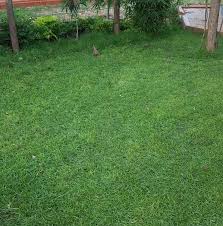Paspalum Grass, scientifically known as Paspalum, is a type of grass that is commonly found in various parts of the world. It is known for its adaptability and ability to thrive in a variety of environments, making it a popular choice for lawns, sports fields, and golf courses.
One of the key features of Paspalum Grass is its durability. It can withstand heavy foot traffic and recover quickly from damage, making it an excellent option for areas that experience a lot of activity. This grass is also known for its tolerance to salt, making it suitable for coastal regions where the soil might have higher levels of salt content.
Paspalum Grass comes in different varieties, each with its own unique characteristics. Some varieties are better suited for low-maintenance landscapes, while others are specifically bred for their fine texture and lush appearance. This variety in traits allows landscapers and homeowners to choose the type of Paspalum Grass that best suits their needs and preferences.
In terms of maintenance, Paspalum Grass is relatively easy to care for. It requires regular mowing to maintain its desired height and appearance. Additionally, proper irrigation is important, as over-watering or under-watering can affect its health. The grass’s ability to adapt to different soil types also contributes to its low-maintenance nature.
Paspalum Grass is not only functional but also aesthetically pleasing. Its vibrant green color and lush growth create visually appealing landscapes. Whether used for a golf course fairway, a soccer field, or a residential lawn, Paspalum Grass adds a touch of natural beauty to the surroundings.
Furthermore, Paspalum Grass plays a role in erosion control. Its dense root system helps stabilize soil on slopes and prevents soil erosion, making it a valuable asset in areas prone to erosion.
In addition, Paspalum Grass, with its scientific name Paspalum, is a versatile and hardy grass species that offers numerous benefits. Its adaptability, durability, low-maintenance nature, and aesthetic appeal make it a popular choice for various landscaping and recreational purposes. Whether you’re looking to create a lush lawn or maintain a sports field, Paspalum Grass is an excellent option to consider.
Read Also: The Origin and Development of Soil (Soil Genesis)
Growing and Care Guide of Paspalum Grass

Growing and caring for Paspalum Grass can be a rewarding experience. Whether you’re establishing a lawn, sports field, or decorative landscape, following these simple steps can help ensure the successful growth and maintenance of Paspalum Grass:
1. Soil Preparation: Start by preparing the soil. Paspalum Grass is adaptable to different soil types, but well-draining soil is essential. Loosen the soil and remove any debris or rocks that could hinder root growth.
2. Seed or Sod Installation: You can establish Paspalum Grass from seeds or sod. Sod provides instant coverage, while growing from seeds might take longer. Follow the recommended planting depth and spacing guidelines.
3. Watering: Proper watering is crucial during the establishment phase. Keep the soil consistently moist but not waterlogged. Water deeply and less frequently to encourage deep root growth.
4. Mowing: Once the grass reaches a height of about 3 inches, you can start mowing. Maintain a mowing height of around 1.5 to 2 inches for most Paspalum varieties. Avoid cutting more than one-third of the grass height at a time.
5. Fertilization: Apply a balanced fertilizer to promote healthy growth. Follow the manufacturer’s recommendations for the specific Paspalum variety you’re growing. Over-fertilization can lead to thatch buildup, so be cautious.
6. Weed Control: Paspalum Grass has good natural weed resistance, but occasional weeding might be necessary. Regular mowing can help prevent weed growth by shading out potential invaders.
7. Pest and Disease Management: Paspalum Grass is generally resistant to many pests and diseases. However, keep an eye out for signs of any issues, such as discoloration, wilting, or unusual growth patterns.
8. Irrigation: Once established, Paspalum Grass is relatively drought-tolerant. Water deeply and infrequently to encourage deep root growth. Adjust your irrigation schedule based on weather conditions and the specific needs of your lawn.
9. Aeration: Periodically aerate the soil to improve water and nutrient penetration to the roots. This helps maintain a healthy root system and overall lawn vitality.
10. Winter Care: Paspalum Grass can go dormant in colder months. While it might lose its vibrant green color, it will usually rebound with warmer weather. Avoid heavy foot traffic during dormancy.
11. Thatch Management: Thatch, a layer of dead grass and roots, can build up over time. Occasional dethatching might be necessary to ensure proper water and nutrient absorption.
12. Soil Testing: Periodically test your soil’s pH and nutrient levels. Adjust fertilization and other practices based on the results to maintain optimal grass health.
Remember that different Paspalum Grass varieties might have specific care requirements, so it’s essential to research the specific type you’re growing. By following these guidelines and monitoring your grass’s needs, you can enjoy a lush and vibrant Paspalum lawn or landscape.
Benefits and Uses of Paspalum Grass
Paspalum Grass offers a range of benefits and has various practical uses, making it a versatile choice for different landscapes and applications. Here are some of the key benefits and uses of Paspalum Grass:
1. Durability: Paspalum Grass is known for its ability to withstand heavy foot traffic and recover quickly from damage. This makes it an excellent choice for high-traffic areas like sports fields, playgrounds, and golf courses.
2. Adaptability: Paspalum Grass is adaptable to various soil types and climates. It can thrive in both tropical and subtropical regions, making it suitable for a wide range of environments.
3. Salt Tolerance: Many varieties of Paspalum Grass have excellent salt tolerance. This makes it a preferred choice for landscapes near the coast where soil salinity can be a challenge.
4. Erosion Control: Paspalum Grass’s dense root system helps stabilize soil, making it effective for erosion control on slopes and hillsides. It reduces the risk of soil erosion caused by water runoff.
5. Aesthetic Appeal: With its vibrant green color and lush growth, Paspalum Grass adds natural beauty to landscapes. Its fine texture contributes to an attractive and manicured appearance.
6. Low Maintenance: Paspalum Grass is relatively low-maintenance compared to some other grass varieties. Its adaptability and ability to resist pests and diseases reduce the need for frequent treatments.
7. Recreational Areas: Due to its durability and playability, Paspalum Grass is commonly used in recreational areas such as golf course fairways, athletic fields, and parks.
8. Residential Lawns: Paspalum Grass can create a soft and inviting lawn that is suitable for families and pets. Its ability to recover from wear and tear makes it a good choice for active households.
9. Drought Tolerance: Once established, Paspalum Grass has good drought tolerance, meaning it can survive periods of reduced water availability.
10. Soil Improvement: Paspalum Grass’s root system helps improve soil structure by increasing aeration and water infiltration. This benefits the overall health of the soil ecosystem.
11. Green Roof Planting: In urban environments, Paspalum Grass can be used as a component of green roofs to enhance insulation, manage stormwater runoff, and create green spaces in cities.
12. Wildlife Habitat: Paspalum Grass can provide habitat and forage for various wildlife species, contributing to local ecosystems.
13. Restoration Projects: Paspalum Grass can be used in habitat restoration projects to stabilize soil, prevent erosion, and promote the return of native vegetation.
14. Soil Stabilization: Along with its erosion control benefits, Paspalum Grass helps stabilize soil on construction sites and other areas prone to soil displacement.
15. Alternative Lawns: In regions with challenging soil conditions, such as clay or sandy soils, Paspalum Grass can serve as an alternative lawn option.
In addition, Paspalum Grass offers durability, adaptability, and aesthetic appeal while serving a variety of purposes. Its uses range from recreational areas and residential lawns to erosion control and soil improvement. Its ability to thrive in various conditions and its functional benefits make Paspalum Grass a valuable asset in landscaping and environmental projects.
Read Also: The Different Factors of Soil Formation
Where to Find Paspalum Grass near Me

Here are three perfect places where you can find or locate Paspalum Grass:
1. Nurseries and Garden Centers: Local nurseries and garden centers often carry a variety of grass species, including Paspalum Grass. They can provide you with information about different Paspalum varieties available and offer guidance on choosing the right type for your specific needs.
2. Landscaping Suppliers: Many landscaping suppliers specialize in providing grass seeds, sod, and other landscaping materials. These suppliers may have a selection of Paspalum Grass options that you can purchase for your lawn or project.
3. Online Seed and Sod Retailers: Numerous online retailers specialize in selling grass seeds, sod, and landscaping materials. These websites provide a convenient way to browse different Paspalum Grass varieties, compare prices, and have the seeds or sod delivered directly to your doorstep.
When searching for Paspalum Grass, it’s important to research the specific type that best suits your climate, soil, and usage requirements. Check with local experts or online resources to ensure you’re selecting the right variety for your intended purpose.
Read Also: Guide to Proper Physical Products & Services Distribution Tasks
